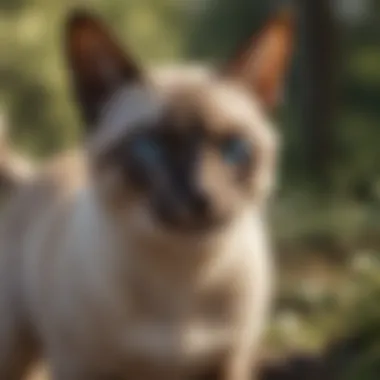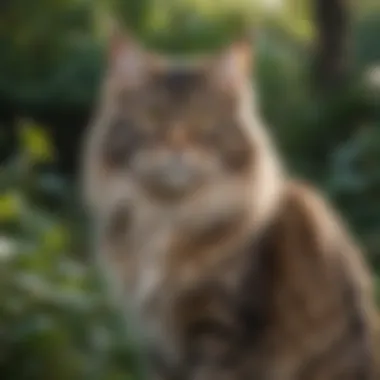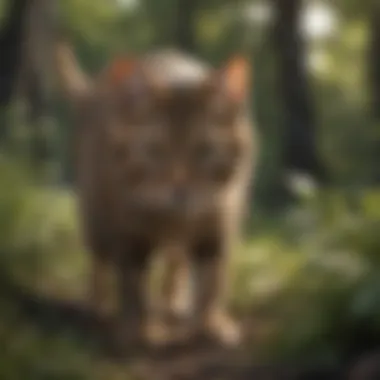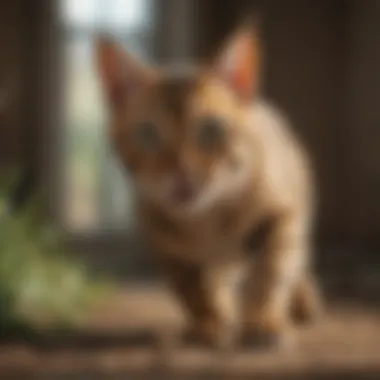Top Cat Breeds for Effective Mouse Hunting


Intro
Cats have long been revered for their hunting skills, particularly their ability to catch mice. This article looks into various cat breeds known for this talent. Some breeds have been selectively bred for their hunting traits, while others possess natural instincts making them skilled hunters. Understanding these breeds helps potential pet owners make informed decisions. This exploration covers everything from physical characteristics to their temperament.
Animal Species Profile
Prelude to the animal species
Domesticated cats, scientifically known as Felis catus, have a fascinating history as companions to humans. They were domesticated around 9,000 years ago in the Near East. Their role has evolved from mere pest control to beloved family pets. Mouse catching remains a critical skill, making certain breeds particularly effective in this regard.
Physical characteristics and appearance
Different breeds of cats show a variety of physical traits that contribute to their hunting capabilities. Breeds like the Siamese and Maine Coon have lean bodies with strong, agile limbs. Others like the American Shorthair have muscular builds. These characteristics aid in swift movements, crucial for stalking and pouncing on prey.
Natural habitat and distribution
Typically, domestic cats adapt to various environments. They can thrive in urban settings, rural areas, and even farms, proving useful in controlling rodent populations. Each breed may prefer a specific environment, such as rural farms for the barn cats like the American Shorthair.
Behavior and social interactions
Cats are solitary hunters by nature, but they can also form strong bonds with humans and other animals. Some breeds are more sociable, like the Siamese, while others prefer independence. Understanding these behaviors helps in choosing the right breed for households, particularly those with young children or multiple pets.
Pet Care & Tips
Choosing the right pet for your lifestyle
When considering a cat for pest control, it’s crucial to assess how its characteristics align with your lifestyle. For example, the Maine Coon is friendly and sociable, making it suitable for families, whereas the Norwegian Forest Cat is independent and might prefer less interaction.
Basic care requirements and habitat setup
Providing a comfortable environment is essential. Cats require basic amenities such as:
- Quality food designed for their age and health
- Clean litter boxes
- Safe spaces to play and explore
Health and wellness tips for pet longevity
Regular veterinary visits are vital to monitor health. Vaccinations and parasite control should not be neglected. Additionally, spaying or neutering contributes to better health and behavior.
Training techniques and behavioral enrichment ideas
Engaging cats in play enhances their hunting skills. Using toys like feather wands or laser pointers stimulates their instincts. Training should be positive and consistent to foster a trusting relationship between the cat and owner.
"Cats are not just pets; they are skilled partners in pest control. "
Epilogue
Choosing the best cat for catching mice involves understanding their unique traits and characteristics. This article presents not just breeds but insights to ensure harmony in households. Selecting the right cat enhances the bond between humans and their feline companions, while addressing practical needs for pest control. The underlying goal is to appreciate the contributions of certain cats while weighing their benefits as pets.
Prelude to Mouse Catching Cats
In the realm of pest control, feline companions have consistently earned their stripes as effective hunters of vermin, particularly mice. Understanding the role of cats in this context is not merely an academic exercise; it offers practical implications for pet owners and those living in rodent-prone environments. This section will explore the significance of the topic by focusing on the characteristics and behaviors that make cats exceptional mousers.
Historically, cats were bred for their hunting abilities. Humans have relied on their keen senses and predatory instincts for centuries to manage rodent populations. In homes, farms, and other settings, cats not only provide companionship but also play a crucial role in safeguarding spaces from unwanted pests.
The benefits of having cats that excel in catching mice go beyond mere pest control. A well-trained cat can reduce the infestation of rodents, thus mitigating damage to property and food supplies. Their presence can deter mice from entering in the first place, thereby maintaining a cleaner and healthier living environment.
Furthermore, understanding the traits that qualify a cat as an efficient hunter can greatly influence the selection process for potential pet owners. Each breed possesses unique traits, instincts, and temperaments that impact their effectiveness in catching mice. By examining these elements, individuals can make informed choices when selecting a feline companion that not only aligns with their lifestyle but also addresses specific needs related to pest control.
For those considering implementing cats as a measure against mice, it's essential to evaluate both their physical capabilities and behavioral traits. The combination of these aspects will ultimately determine how well a cat performs its role as a mouser.
This article aims to bridge the gap between practical pest control needs and the characteristics that different cat breeds can offer. In doing so, it provides valuable insights for responsible pet ownership, particularly in environments where rodents pose a significant threat.


"Cats are natural born hunters, their instincts firmly embedded in their DNA, making them one of the best solutions for dealing with mice."
Historical Context of Cats as Rodent Hunters
Understanding the historical context of cats as rodent hunters is crucial for grasping their role in human society and the natural world. From ancient civilizations to modern agricultural practices, cats have been valued not just as companions but also as functional allies against pests. Cats are efficient hunters, possessing instincts and physical attributes that make them particularly adept at tracking and capturing rodents, a significant concern for humans throughout history.
Historically, the utility of cats in controlling rodent populations paved the way for their domestication. Their relationship with humans was built on mutual benefit. While humans provided food and shelter, cats helped keep the environment free of pests that could damage crops and spread disease. This dynamic highlights the practical advantages of having cats around, especially in rural settings where agriculture is present.
In this section, we will delve deeper into two important aspects: the origins of the feline relationship with humans and the specific role that cats played in agricultural practices.
Origins of the Feline Relationship with Humans
The origins of the relationship between cats and humans can be traced back to around 9,000 years ago in the Near East. As humans transitioned from nomadic lifestyles to settled farming, they began to cultivate grains. This change in lifestyle attracted rodents, which in turn drew wild cats seeking an easy food source. The cats that were less skittish around humans found comfortable niches near granaries, leading to a form of natural selection favorable to the more sociable felines.
Over time, humans recognized the benefits of having these natural predators around. They began to tolerate and care for the cats, leading to an early type of domestication. This relationship allowed for effective pest control while also forming an emotional bond between species. The establishment of this alliance marked the genesis of the domesticated cat, paving the way for its presence in human homes today.
The Role of Cats in Agriculture
Cats' roles in agricultural settings are multifaceted and crucial in pest management. By controlling populations of mice and other small rodents, cats prevented possible damage to crops and resources, thus increasing yields and ensuring food security for communities.
Some key points about the role of cats in agriculture include:
- Pest Control: Cats are skilled hunters that reduce the number of rodents that can consume and ruin crops.
- Natural Predators: Unlike chemical pesticides, cats do not leave harmful residues.
- Cultural Significances: In some cultures, cats were considered sacred and associated with various practices aimed at preserving harvests.
In summary, the historical context of cats highlights their significance as mouse catchers. Their relationship with humans has evolved from purely functional to one nestled in companionship. Today, this history informs how we view cats — not only as pets but also as effective aids in managing wildlife and ensuring stability in agricultural practices.
Physical Traits of Effective Hunter Cats
Understanding the physical traits of cats that make them effective hunters is crucial for those interested in feline companions, especially in environments where mice might pose a problem. Certain physical characteristics optimize a cat's ability to hunt and catch prey. This section discusses several key elements that contribute to a cat's success as a rodent hunter.
Size and Build
The size and build of a cat can influence its hunting effectiveness. Typically, a larger cat may have an advantage in strength, which can be beneficial when tackling a mouse. However, a smaller cat can often be quicker and more agile. Breeds like the Maine Coon exhibit a robust build, combining size with agility, making them versatile hunters.
In contrast, Siamese cats, while smaller, are renowned for their speed and agility. They can quickly navigate tight spaces, allowing them to chase down elusive mice. Thus, the ideal size for a mouse-catching cat depends on the hunting strategies that will be used in a given environment.
Larger cats may be powerful, but smaller ones often display unmatched agility, making them both effective hunters.
Moreover, the body structure plays a role. Cats with a long body can utilize their length to stretch and reach better when pouncing. Additionally, the muscular build of a cat can greatly influence its stamina during chases. This stamina is critical in pursuing prey which can be swift and unpredictable.
Claw Structure and Hunting Gear
The claw structure of cats is another significant factor in hunting efficiency. Cats have retractable claws which they can sheathe when not hunting. This design allows for silent movements, an essential advantage while stalking prey. When it comes to catching mice, a quick swipe or pounce may be a life-or-death moment.
Claw sharpness and strength are also important. A cat's claws must be well-maintained to be effective. Regular scratching helps, but the genetic makeup of breeds such as Bengals provides them with claws that are more adept at gripping and holding onto prey.
Additional hunting gear, such as their teeth, also come into play. Healthy teeth aid in delivering a quick kill, ensuring efficiency when catching mice. The combination of claws and teeth ensures that a cat can capture and control its prey effectively.
In summary, the physical traits of cats, especially their size, build, and claw structure, directly affect their success in hunting. Understanding these traits can assist potential cat owners in selecting a breed that is not only a companion but also an efficient hunter.
Instincts and Behaviors of Hunting Cats
Understanding instincts and behaviors is crucial when considering the most effective mouse-catching cats. These innate qualities drive a cat's ability to hunt and capture rodents, making them vital companions in managing pest problems. Cats possess a set of natural instincts that are finely tuned to hunting, and these characteristics vary among different breeds.
Predatory Instincts
Predatory instincts are fundamental for any cat’s success as a hunter. Cats have evolved as solitary hunters. Their skills in stalking, pouncing, and capturing prey are hardwired into their behaviors. Although domesticated, many cats retain these instincts. The ability to observe and strategize when hunting reflects their ancestral lineage. Cats generally exhibit several key behaviors during such instances:
- Stalking: Cats are experts at moving quietly and slowly, often positioning themselves behind obstacles to ambush their target. This patient approach gives them the upper hand when hunting.
- Pouncing: A powerful leap allows cats to catch quick-moving prey. They use their strong legs to generate the necessary force.
- Grooming: After a hunt, cats often groom themselves. This behavior not only keeps their fur clean but also serves to calm them after an adrenaline rush.
These instincts ensure that a cat can be an effective mouse catcher. The unpredictability of mice requires a cat that can think and react quickly. A cat's size and agility play a role, but their instinctual behaviors are what truly set them apart as proficient hunters.


Play Behavior as Practice
Play behavior in cats is more than just a source of entertainment; it's a vital precursor to their hunting skills. Kittens often engage in play fighting, which mirrors real hunting tasks. These playful interactions develop essential techniques needed for actual hunting. As they bat at toys, leap, and chase, they hone their reflexes and coordination.
Here are some interesting elements surrounding their play behavior:
- Practice: During play, cats practice stalking and pouncing without the direct pressure of a hunt. This gives them the opportunity to refine their skills.
- Social learning: Kittens learn from their mothers and littermates. They observe and imitate various behaviors, which establishes a foundation for them when they later encounter real prey.
- Mental Stimulation: Regular play keeps their minds sharp. A mentally engaged cat is more responsive and adaptable during actual hunting scenarios.
"Playtime is not only vital for physical health but also for the cognitive and instinctual development of future hunting skills."
Best Breeds for Catching Mice
Understanding which cat breeds are best suited for catching mice is crucial for anyone facing challenges with rodent infestations. Certain breeds have been recognized for centuries for their skills in hunting, making them ideal companions not just for their charm but also for their efficiency. In this section, we will explore several cat breeds known for their prowess in hunting mice, examining their specific traits and characteristics that contribute to their hunting abilities.
When selecting a cat for this purpose, consider factors such as instinct, temperament, and adaptability. The breeds discussed here offer a blend of these qualities, ensuring that not only can they assist with pest control, but they can also integrate well into home life.
Siamese Cats
Siamese cats are distinguished by their vocal nature and strong personalities. They are agile and intelligent, making them effective hunters. Their slender bodies allow for remarkable speed and flexibility.
These cats are naturally curious and tend to explore their surroundings thoroughly. This curiosity aids them in hunting as they investigate potential hiding spots for mice. Their strong predatory instinct ensures they are attentive and quick to react, traits essential for catching pests. However, prospective owners should be aware that Siamese cats require stimulation and engagement to keep them active and minimize boredom.
American Shorthair
The American Shorthair is renowned for its robustness and straightforward temperament. This breed is particularly well-suited for hunting due to its muscular build and strong features. Their size gives them an advantage in terms of strength, while their keen senses help them track and catch small animals like mice.
These cats are also adaptable, which makes them comfortable in various environments. The American Shorthair actively engages in play, replicating hunting behaviors that are beneficial for a pest control role. Their easygoing nature makes them good companions for families, while their hunting skills help keep homes rodent-free.
Maine Coon
Maine Coons are one of the largest domesticated cat breeds, characterized by their tufted ears and bushy tails. Their size does not limit agility; instead, it enhances their ability to hunt larger prey if necessary. Known as "gentle giants," they possess a friendly demeanor but retain strong hunting instincts.
These cats are known for their intelligence and problem-solving skills. They often use their keen instincts to stalk and capture their prey effectively. Maine Coons also have a playful side, which helps them practice their skills. Their energetic nature and curiosity can make them excellent hunters in a homely setting.
Bengal Cats
Bengal cats are visually striking, possessing a wild appearance reminiscent of their leopard ancestors. This breed is highly energetic and curious, traits that play a significant role in their hunting abilities. Bengals are agile and possess a natural instinct for chasing moving objects.
Their playful nature means they are often engaged in activities that mimic hunting behavior. Bengals can jump high and run fast, making them effective in catching mice and other small animals. However, potential owners of Bengal cats should be prepared for their energetic lifestyle, requiring ample play and activity to keep them stimulated.
British Shorthair
British Shorthairs are well-loved for their round faces and dense, plush coats. While they may seem more reserved compared to other breeds, they possess strong hunting instincts. Their build is solid, providing them with strength necessary for catching prey.
These cats are also patient, often quietly observing their environment before making a move. British Shorthairs engage in hunting games, which can refine their skills. Their laid-back personality makes them suitable for families, providing companionship while still being effective at pest control.
Temperament and Adaptability
When choosing a cat for the purpose of catching mice, understanding the aspects of temperament and adaptability is crucial. These traits determine how well a cat will interact with its environment and how effective it will be in a role requiring hunting instincts. Cats that have the right personality and can adjust to domestic life can blend their natural predatory skills with the comforts of home living.
A cat's temperament influences its interaction with humans, other animals, and its surroundings. Playfulness, curiosity, and independence are common traits among effective mouse-catching cats. A more active cat, for instance, will pursue and hunt more vigorously than a less active counterpart. Additionally, the adaptability of a cat to a home indoors versus potential outdoor access plays a significant role in its overall effectiveness in keeping rodent populations at bay.
Understanding Cat Personalities
Every cat has a distinct personality, which significantly affects its hunting capabilities. Some cats are more reserved, while others exhibit bold behaviors, which can impact their efficiency in hunting mice. For example, a Siamese cat, known for its energetic and social nature, typically engages in play that simulates hunting. This not only enhances their skills but also provides a better bond with their owners.
Understanding the personality traits of various breeds can offer insights on which type of cat to choose based on one’s environment. More reserved or shy cats might not take as many opportunities to hunt mice, whereas more active breeds like the Bengal will actively seek out opportunities to hunt, making them more suitable for pest control.
Here are important personality traits to consider when selecting a cat for mouse catching:
- Activity Level: High-energy cats tend to chase and hunt effectively.
- Curiosity: Cats that explore frequently also exhibit better hunting instincts.
- Social Behavior: Some cats work better in environments where they can interact with humans or other pets.


Compatibility with Domestic Life
The compatibility of a cat with a domestic life stretches beyond its ability to catch mice. This aspect includes how well the cat can adjust to household routines and various living conditions. A cat that can manage its hunting instincts without becoming overly disruptive or aggressive makes for a more harmonious home environment.
In domestic settings, it is essential that any mouse-catching breed is not only effective in their primary task but also adaptable to living with people. This may mean meeting expectations for litter training, tolerating handling, or becoming accustomed to children or other pets. A cat that fits seamlessly into domestic life can provide additional emotional support as a companion.
A few key factors for compatibility in homes include:
- Temperament Alignment: Choosing a cat whose personality meshes well with the household's dynamic.
- Noise Levels: Cats should be able to balance their hunting behaviors without causing excessive disruptions.
- Space Considerations: Understanding how the home environment, whether small or spacious, affects the cat’s ability to thrive.
Ultimately, selecting a cat that has both the right temperament and adaptability is essential. This ensures not only effective mouse catching but also a balanced and fulfilling relationship with the households they inhabit.
Considerations for Mouse-Proofing Your Environment
Ensuring a mouse-proof environment is vital when keeping cats, especially for those relying on them for rodent control. A proper living space can maximize a cat's natural hunting instincts while also supporting their well-being. This section highlights key elements and benefits of effectively preparing your home for both cats and the potential challenges of mouse infestations.
Creating a Suitable Living Space for Cats
A suitable living space is paramount to fostering an environment where cats can thrive. It is important to consider the following:
- Safety: Keep harmful substances, like pesticides, out of reach. Cats should roam freely without risking their health.
- Accessibility: Create spaces that provide easy access for the cats. This includes high perches and quiet areas to retreat when they feel overwhelmed.
- Comfort: Provide soft bedding and places where they can relax. This will encourage them to feel at home, which is essential for effective hunting behavior.
- Stimulation: Incorporate toys that mimic the movements of mice. This will engage their predatory instincts and keep them mentally active.
When creating a space for your cat, consider how they interact with their surroundings. The layout of furniture, hiding spots, and vertical spaces contribute to a cat's play and hunting practices.
Additional Mouse Deterrent Strategies
To maximize the effectiveness of your mouse-catching cats, additional strategies can be employed:
- Seal Entry Points: Mice can enter homes through small cracks and openings. Inspect your home and seal any gaps to prevent mice from infiltrating.
- Maintain Cleanliness: A clean environment reduces the chances of attracting mice. Remove food scraps and store pet food in airtight containers.
- Use Natural Repellents: Scents like peppermint and vinegar can deter mice. Using these in strategic locations can keep rodent populations at bay without harming your cats.
- Limit Hiding Spaces for Mice: Organize clutter, both inside and outside your home, to minimize hiding areas for mice. Stack firewood in a way that reduces shelter.
"An interactive environment combined with good housekeeping practices can significantly enhance a cat's ability to tackle rodent problems efficiently."
By considering these factors, you create not only a supportive environment for your cats but also a less hospitable one for mice. It is essential to strike a balance to ensure both pests and pets are managed effectively, contributing to a harmonious home.
The Importance of Spaying and Neutering
Spaying and neutering are crucial topics for pet owners, especially for those who consider cats as both companions and natural pest control. These procedures are not just about population control; they hold significant importance for the health and behavior of cats. Understanding these aspects can contribute to the overall well-being of feline companions.
One of the primary benefits of spaying and neutering is reducing unwanted litters. Cats can reproduce at a young age, often leading to multiple litters in a year. Each litter can range from two to six kittens or more. This leads to an overwhelming number of cats that may not find homes. When owners take the initiative to spay or neuter, they directly contribute to the reduction of stray and abandoned animals in shelters.
- Unspayed female cats can produce several litters annually.
- Neutered male cats are less likely to engage in territorial behaviors.
- Spaying helps to prevent certain health issues, such as uterine infections and breast tumors.
Reducing Unwanted Litters
With spaying and neutering, the population of stray cats reduces significantly. Not only does it alleviate the burden on animal shelters, but it also ensures that existing cats have better living conditions. The result is a healthier feline habitat, where resources are better allocated for those already in care. Without spaying or neutering, the cycle of unwanted litters continues, leading to overcrowding in shelters and more cats living unsheltered outdoors.
"Spaying and neutering not only promote a healthier pet population but also enhance the bond between humans and their animal companions."
Behavioral Benefits
Behaviorally, spaying and neutering lead to more balanced temperaments in cats. Neutered males tend to exhibit less aggression and are less likely to roam in search of female cats. This reduced territory behavior is beneficial for both the cat and the owner. Furthermore, spayed females are less likely to go into heat, which can manifest in loud vocalizations and other disruptive behaviors.
- Less aggressive behaviors aid in a harmonious household.
- Reduced incidence of escape attempts.
- Spaying can eliminate heat-related behaviors, making for a quieter home environment.
Overall, incorporating spaying and neutering into the lifecycle of pet ownership fosters healthier and more adaptable cats. This reflects positively on the relationship between humans and pets. Given the instinctual nature of cats, providing a stable, caring environment can result in feline companions that are both effective at catching pests and wonderful to have as loyal friends.
Ending
In summary, this article has provided a thorough examination of cats that excel at catching mice. The significant themes covered include the historical context of cats as rodent hunters, their unique physical attributes, and behaviors intrinsic to effective hunting. Understanding these elements is vital for anyone considering bringing a cat into their home, especially in environments with a potential rodent issue.
The choice of cat breed is not solely determined by aesthetic preferences. Temperament, adaptability, and hunting skills weigh heavily in making the right selection. Breeds like the Siamese and Maine Coon, known for their energetic and playful nature, also bring unmatched benefits in pest control. These cats not only protect your space but also provide companionship, fulfilling more than just a functional role.
A responsible owner should also consider the importance of spaying and neutering. This measure ensures that unwanted litters are minimized and addresses behavioral aspects that may affect hunting efficiency. Moreover, proper living conditions and additional rodent deterrent strategies can foster a more conducive environment for hunting.
It is essential to recognize that while cats are natural hunters, human guidance and care significantly enhance their effectiveness. The intersection between instinct and nurturing plays a vital role in developing competent rodent catchers.
By understanding the traits and needs of different breeds, potential cat owners can make informed decisions that lead to a harmonious home life and effective mouse control. Ultimately, the bond between a cat and its owner can flourish when there is knowledge about the best practices for rearing these remarkable hunters.







